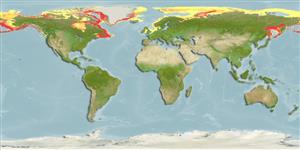Environment: milieu / climate zone / depth range / distribution range
Écologie
marin démersal; profondeur 12 - 930 m (Ref. 58426), usually 125 - 150 m (Ref. 56590). Polar; -2°C - 8°C (Ref. 4698); 84°N - 45°N, 180°W - 180°E (Ref. 117245)
Arctic to Northwest Atlantic: Ungava Bay, Gulf of St. Lawrence in Canada and Greenland; Kara Sea and southeastern part of Barents Sea (Ref. 4698).
Taille / Poids / Âge
Maturity: Lm ? range ? - ? cm
Max length : 21.0 cm TL mâle / non sexé; (Ref. 56590); common length : 12.9 cm TL mâle / non sexé; (Ref. 56590); poids max. publié: 160.00 g (Ref. 56590); âge max. reporté: 7 années (Ref. 56590)
Épines dorsales (Total): 8 - 9; Rayons mous dorsaux (Total): 18-22; Épines anales 0; Rayons mous anaux: 13 - 18. Young with 2 dark blotches on body, which break up into small dark brown spots in adults; spinous dorsal fin with 1-2 round dark patches, soft part with a few comparatively broad dark stripes; upper part of pectoral fin with transverse stripes; anal and pelvic fins colorless; caudal fin with irregular spots (Ref. 4698).
Found on sand or sandy-mud bottoms with stones with salinities of 24.7-34.2 ppt (Ref. 4698). Benthic (Ref. 58426). Feeds mainly large bottom invertebrates, rarely small mollusks (Ref. 4698).
Life cycle and mating behavior
Maturité | Reproduction | Frai | Œufs | Fécondité | Larves
Robins, C.R. and G.C. Ray, 1986. A field guide to Atlantic coast fishes of North America. Houghton Mifflin Company, Boston, U.S.A. 354 p. (Ref. 7251)
Statut dans la liste rouge de l'IUCN (Ref. 130435)
Menace pour l'homme
Harmless
Utilisations par l'homme
Plus d'informations
RéférencesAquacultureProfil d'aquacultureSouchesGénétiqueElectrophoresesHéritabilitéPathologiesTraitementNutrientsMass conversion
CollaborateursImagesStamps, Coins Misc.SonsCiguateraVitesseType de nageSurface branchialeOtolithesCerveauxVision
Outils
Articles particuliers
Télécharger en XML
Sources Internet
Estimates based on models
Preferred temperature (Ref.
123201): -1.5 - 4.2, mean -0.5 °C (based on 376 cells).
Phylogenetic diversity index (Ref.
82804): PD
50 = 0.5000 [Uniqueness, from 0.5 = low to 2.0 = high].
Bayesian length-weight: a=0.00676 (0.00300 - 0.01523), b=3.17 (2.98 - 3.36), in cm total length, based on LWR estimates for this (Sub)family-body shape (Ref.
93245).
Niveau trophique (Ref.
69278): 3.9 ±0.5 se; based on diet studies.
Résilience (Ref.
120179): Milieu, temps minimum de doublement de population : 1,4 à 4,4 années (Preliminary K or Fecundity.).
Fishing Vulnerability (Ref.
59153): Low vulnerability (11 of 100).
